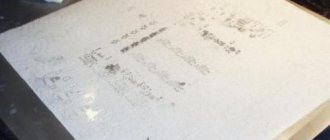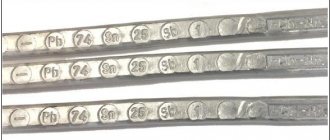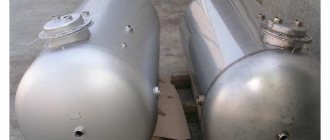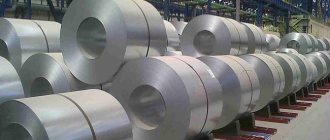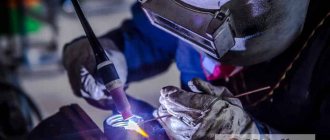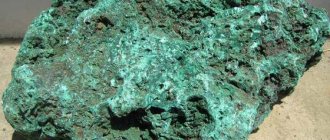Valve lapping paste is necessary to perform the valve lapping process. This procedure is performed when replacing valves with new ones or when performing a major engine overhaul. There are two main types of lapping pastes - homemade and factory-made. The first type came to us from the distant past, when such compositions were made from scrap materials. However, currently, most car enthusiasts and auto repairmen use factory pastes for grinding valves. There are two reasons for this. The first is the better performance characteristics of factory-made products, and the second is the reluctance or impossibility of producing professional lapping paste yourself.
Currently, a wide range of different lapping pastes are sold on the shelves of auto stores. They differ in their characteristics, grain size, features of use and, of course, brands. At the end of this material there is a list of the most popular such products among domestic car enthusiasts. The rating is not of a commercial nature, that is, it does not advertise any product, but is based only on reviews from car enthusiasts.
| Name of the paste | Brief description and features | Package size, ml/mg | Price of one package as of the beginning of 2022, rubles |
| Lapping paste "VMPAuto Classic" | The product is intended for treating valves of both gasoline and diesel engines. The grain size of the paste is 75...90 microns, and decreases during operation. Consumption is 0.2 grams per valve. | 40 grams; 400 grams; 1 kg | 150 rubles; 730 rubles; 1100 rubles |
| VMPAuto Professional lapping paste | The paste is intended for use in gasoline engines only. The grain size is 50...80 microns. Rubbing time is 2 minutes. Consumption - 0.2 grams per valve. Very high quality composition. | 40 grams; 400 grams; 1 kg | 175 rubles; 900 rubles; 1300 rubles. |
| Lapping paste "VMPAvto Diamond" | The paste is designed specifically for use in diesel engines. It is a professional product that can be used in a car service. The consumption is the same - 0.2 grams per valve. Rubbing time is 2 minutes. | 10 grams; 40 grams; 400 grams; 1 kg | 115 rubles; 275 rubles; 1500 rubles; 1900 rubles. |
| VMPAvtoFabo lapping paste | Positioned as a premium lapping paste, which must be used as a finishing paste after using the products described above. Provides a bronze coating on the valve disc. Greatly increases engine compression. | 40 grams | 220 rubles |
| ABRO Grinding Paste GP-201 | A very good and inexpensive tool for grinding valves on any engines, both gasoline and diesel. One jar has two compartments, where coarse-grained (COARSE) and fine-grained (FINE) pastes are located. The product is very popular among car enthusiasts and craftsmen. | 140 grams | 180 rubles |
| Abrasive lapping paste Done Deal | One package contains two tubes of medium-grained and fine-grained lapping pastes. Using this product you can process any valves and their seats (seats). One and the second paste can be used either sequentially one after the other or separately. The product is positioned as professional, so it can be used in auto repair shops | 2×23 grams | 300 rubles |
| Permatex valve lapping paste | Pernatex lapping paste is positioned by the manufacturer as a universal tool that can be used to grind not only valves, but also other parts, including those coated with chrome. Excellent for removing burrs, dirt, deposits, etc. Before use, the composition must be mixed with water to obtain a paste-like consistency. | 85 grams | 530 rubles |
| Valve grinding paste “Effect” | Two-component lapping paste. One package contains two bottles with roughing and finishing paste. The bottles have dispensers that allow you to conveniently apply the product to the surface of the valve. The paste's performance is average. However, it has one undeniable advantage - low price. | 2×86 grams | 100 rubles |
What is valve lapping and why is it needed?
Most domestic cars, especially the old model, 1970–1991, have four-cylinder, eight-valve engines. That is, each cylinder has two valves - an intake valve, which admits the combustible mixture into the combustion chamber, and an exhaust valve, which discharges spent exhaust gases into the manifold.
A car valve looks like a nail with a wide head, with which it plugs the hole in the combustion chamber. The cap, or more correctly, the valve plate, fits its edge (chamfer) tightly to the seat - the edge of the hole in which it is installed. The cleaner and smoother the edges of the plate and seat, the better the valve closes the hole, which means the engine power, without loss, is directed to the movement of the pistons.
Over time, the edges of the plate and seat become covered with soot and carbon deposits, which violates the tightness of the combustion chamber. This negatively affects engine power and efficiency and increases oil consumption.
If you do not clean the valves regularly, then the hot exhaust gases will sooner or later melt the plate itself, rendering the valves unusable, and consequently the entire engine.
Since the procedure for removing the engine head is quite labor-intensive, it makes sense to combine the work carried out on its components and parts. For example, when replacing the engine head gasket, you can at the same time change the oil rings on the pistons and clean the valves.
The need for cleaning is difficult to determine visually, but there is an easy way to understand how necessary it is. You need to pour kerosene or gasoline into the combustion chambers, directly onto the valve plates, and leave them like that for 12 hours. If the liquid leaks out during this time, it means that it has leaked between the plate and the seat, which means cleaning and grinding are necessary.
In general, it is believed that valves need to be cleaned and ground in every 50,000 km . But this figure is also inaccurate, since the manner in which the engine is used plays a role, because it can operate under strong, sporting loads, or maybe in a gentle mode on good, clean fuel.
A little materiel
For those who are not in the know, it is worth explaining that the valves are located in the cylinder head. There are at least two valves for each cylinder (in most cars). One valve allows the fuel-air mixture to enter the cylinder (combustion chamber) from the intake manifold, and the other releases exhaust gases into the exhaust manifold.
Of course, the valves open one by one. The valves look like a nail. The head, which is also called a plate, is facing the inside of the cylinder. In the closed state, the valve head is in the seat and hermetically closes the combustion chamber, pressing the working chamfer against the seat.
We also recommend reading the article about the timing device. From this article you will learn about the purpose, operating principles and other features of the engine gas distribution mechanism.
Grinding methods
There are several grinding methods. Each has its own characteristics, which are described below.
Hand cutters
A hand cutter is a stick with a suction cup at the end. The procedure is as simple as starting fire. The rubber suction cup is installed on the valve plate, the chamfer of the plate and the seat are pre-treated with a special lapping paste, and the rotation of the strip between the palms begins - left, right. A normal valve usually takes from 15 to 20 minutes.
This method is used by true connoisseurs of rare cars, receiving moral pleasure from this process. With this grinding method, it is impossible to damage the plate itself, the valve stem or seat. Visually, after processing, the chamfer of the plate becomes matte, like the saddle.
Machine tools
There are special mobile machines for lapping valves. They are used by professional car mechanics in their workshops. These are devices of type: VM1150, VM1200, VM1350, VM1500 or VM1600. They differ in the size of the plates being processed and the depth of immersion. There are also special stands for lapping valves, type R-23.74, they are capable of processing 8 valves at once, and are designed for a wide variety of car models - from cars to heavy trucks.
Workbench and tube with T-handle
A tube with a T-handle is another device used for gently grinding in the valves of vintage cars. In this case, at the end of the tube there is a mount for the rod, and the handle rotates the valve in the seat. The method does not tolerate haste and force. It removes a minimal layer from the fragile and thin valve plate. But this method takes quite a lot of time.
Using a drill
Using an electric drill is the most controversial method among professional auto repairmen. With this method, the valve stem is clamped into the drill chuck itself or through a flexible rubber hose. The drill must be reversible, with the ability to rotate the rod in both directions at ultra-low speeds. Undoubtedly, this method significantly reduces the grinding time - one valve takes from 1 to 2 minutes. But there is a risk of scratching the plate or seat, leaving deep scratches on them, or even breaking the valve stem.
Important! Grinding in with an electric drill can only be carried out by professionals who can determine the quality by eye and have a steady hand accustomed to working with this tool.
Why grind valves?
Lapping is a type of polishing when abrasive particles, falling between parts of different hardness, are embedded in a softer material. As a result, the surface cleanliness of the harder product in the friction pair increases. Lapping compounds are widely used in auto repair practice to obtain the correct alignment of the angular dimensions of the valve and seat. For properly lapped valves, the contact surface area approximately doubles.
High-quality valve grinding thus solves two problems:
- Creates a better seal between the valve and the head, which will prevent gases from escaping during the compression stroke.
- Prevents valve burning as the increased contact area allows for better heat transfer from the valves to the head.
Lapping is carried out by applying a special composition - valve lapping paste - to the edges of the valves, followed by their rotation along the head.
What lapping paste should I use?
At the dawn of the automotive industry, dust from diamond wheels mixed with engine oil was used to grind valves. Today, these mixtures are replaced by a variety of grinding pastes. They differ in the content of abrasive elements, fraction sizes and, accordingly, price.
The paste is selected depending on the degree of contamination, quality and grade of valve metal, year of manufacture and engine model. The grinding method – manual or mechanical – also matters.
An important factor in choosing a paste is the experience of the master . For example, a beginner using coarse paste can easily damage a valve or seat. Therefore, for novice craftsmen, it is recommended to use a fine-grained paste, while grinding in with this product will take more time.
Automotive stores sell coarse-grained paste called “Classic” or “Diamond” for initial lapping. For final grinding, FABO paste is used - a finishing anti-friction, non-abrasive treatment. This paste is sold in a set of two tubes, with large fractions and a grinding one.
There are also multifunctional pastes such as ABRO Grinding Paste GP-201. It can not only grind valves, but also clean rust from metal parts and even be used to sharpen cutting tools, such as planes. Its price is much lower than the special “FABO”, so, as they say, it will come in handy on the farm.
“PERMATEX” or “Done Deal” pastes are also used for polishing chrome parts, since they do not contain technical diamond, but silicon carbide.
Important! Before buying a paste, you need to carefully read its composition and range of applications.
If the repair finds the driver without paste, and it is impossible to postpone the grinding - the engine has already been disassembled, you can mix abrasive removed from ordinary, fine sandpaper with oil, and for final polishing use the paste of the State Optical Institute or better known as GOI paste.
How to prepare PP yourself
How to make your own lapping paste. Below we will look at 2 main recipes that have proven effective in practice.
Recipe #1
For preparation you will need the following items:
- Plastic container with a wide neck. The optimal container volume is 200-400 ml.
- Low viscosity motor oil. It is not recommended to use liquid types of oil - in this case, the quality of the mixture will be low and processing will turn into torture.
- Several sharpening stones (2 or more). The abrasive should be fine. The shape of the stone can be any: circle, square, rectangle, oval.
- Large white sheet (A5 or A6). The paper is placed on a workbench or table (even the cleanest table may contain microparticles of debris or dust).
- A clean work table or workbench. It is recommended to wash and dry the table before work. This will prevent water or foreign ingredients from getting into the mixture.
To prepare the lapping paste, place a clean piece of paper on your workbench or workbench. Then place the first stone on top. Take the second stone in your hand and make them progressive and return the movements on the first stone. As a result, you will get the abrasive crumbs necessary for making paste. You only need to rub the stone against the stone for a very short time – no more than 2 minutes. After this, carefully take a sheet of paper in your hand and pour the crumbs into a plastic container. Pour machine oil into the container (the proportion of oil to crumbs is one to one). Mix the mixture well until a homogeneous paste forms. The lapping paste is ready: it can be applied to the engine.
Recipe #2
Let's also look at an alternative PP recipe. We will need all the same elements as in the previous case: white paper, a plastic container, oil, a table or workbench. The only important difference is that you need to use building bricks instead of a block. Instead of solid brick, you can use pieces of it (however, such pieces should have smooth edges). The algorithm for preparing the grinding mixture will be almost identical:
- Clean the table from dust, wash and dry. Then place a white sheet of paper on the table.
- Place the brick on a piece of paper. Take the second brick in your other hand.
- Now you need to get the brick chipped - to do this, rub the first brick with the second brick.
- The brick should be cut no more than 2-3 minutes - during this time the required amount of crumbs should be formed.
- Move the bricks to the side, carefully take a sheet of paper, pour the crumbs into a plastic container.
- Pour 1:1 machine oil into the crumbs and stir until smooth.
Checking the quality of lapping
As already mentioned, only a professional will be able to see by eye how well the valves were ground in. But even they check the grinding of the plate with the seat using kerosene, gasoline or just diesel fuel. To do this, the cylinder head is installed strictly horizontally on a flat surface, and liquid is poured into the cylinders. If after 12 hours the kerosene level in one of the cylinders has decreased significantly, you will have to repeat the grinding of both valves again. If there are 4 valves in the cylinder, that is, 2 intake and 2 exhaust, then the grinding will need to be repeated on all 4.
There is an opinion that valve grinding should be done not only after 50,000-60,000 km, but also on new cars. It is clear that the procedure is not required on budget sedans or other ordinary cars. But it is mandatory on sports cars, since there, every kPa of compression, every horsepower plays a role. So, when preparing a sports car for racing, you cannot do without lapping the valves. And here the test is not only a visual or kerosene test, but also on the race track.

